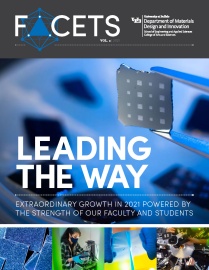Computational research professionals share career advice with students

PhD student Aditya Sonpal asks the panelists about their transition from academia to industry. Panelist are (from left to right), Mardochee Reveil, PhD, Corning; Janice Steckel, PhD, National Energy Technology Lab; and UB alums Suddha Talukdar, PhD ’04, Intel; and Scott Wierzchowski, PhD ’03, Shell Oil. Photo credit: Maximilian Kapitonoff.
by Jane Stoyle Welch
Published April 24, 2019 This content is archived.
Students in computational research groups at UB (and those interested in them) had the opportunity to learn about their job prospects after graduation from a panel of distinguished experts at the annual Symposium on Job and Career Perspectives for Students in the Computational Sciences.
Held on April 12, 2019, the last day of the week-long CDSE Days, industry professionals, including two UB alumni, shared their perspectives and insights on the nature of their work, the job situation in the profession, and opportunities with specific employers with about 40 students.
“We started this event because students still perceive computational work as a niche in more traditional industries such as the chemical and materials field,” said Johannes Hachmann, assistant professor in the Department of Chemical and Biological Engineering. “Our goal is to show them that these fields have been changing dramatically in recent years, that computational research has been moving front and center, and that computational skills open additional paths well outside the mainstream jobs.”
“We also believe that it is important to demonstrate to our students that the things they learn in our research groups are useful - and in fact frequently used - beyond the academic setting,” Hachmann added.
“This career symposium gives us a chance to ask questions to successful people from the industry, who began as computational scientists in graduate school, and got to where they are today,” said Aditya Sonpal, PhD student in chemical engineering.
Sonpal, a graduate student in the Hachmann Research Group, chaired the symposium and moderated the panel discussion. He is president of the UB Computational Sciences Club, which provides graduate students with the opportunity to learn about computational tools and techniques, build new skills, share research ideas, and organize events. The club has organized the symposium for the past five years.
“Overall, the symposium gives us a great platform where we can ask questions without fear of being judged and clarify doubts that students may have regarding how to successfully pursue computational research and land jobs in the industry,” added Sonpal.
This year’s lineup of speakers were:
- Scott Wierzchowski, PhD, Shell Oil, previously Schlumberger (UB PhD ’03, chemical engineering)
- Janice Steckel, PhD, National Energy Technology Laboratory
- Mardochee Reveil, PhD, Corning, previously Intel
- Andrew Taube, PhD, DE Shaw Research, previously Sandia National Lab
- Suddha Talukdar, PhD, Intel (UB PhD ’04, MS ’00 chemical engineering)
Abani Patra, the director of UB’s Institute for Computational and Data Sciences (ICDS) and the Center for Computational Research (CCR) and a professor in the Department of Mechanical and Aerospace Engineering, opened the event and introduced both the CDSE graduate program and CDSE Days.
The symposium was sponsored by the School of Engineering and Applied Sciences, Department of Chemical and Biological Engineering, Department of Materials Design and Innovation, Computational and Data-Enabled Science and Engineering Graduate Program, New York State Center of Excellence in Materials Informatics, Center for Computational Research, Center for Unified Biometrics and Sensors, Graduate Student Association (GSA) and the Computational Sciences Club.
Photo credit: Maximilian Kapitonoff.



